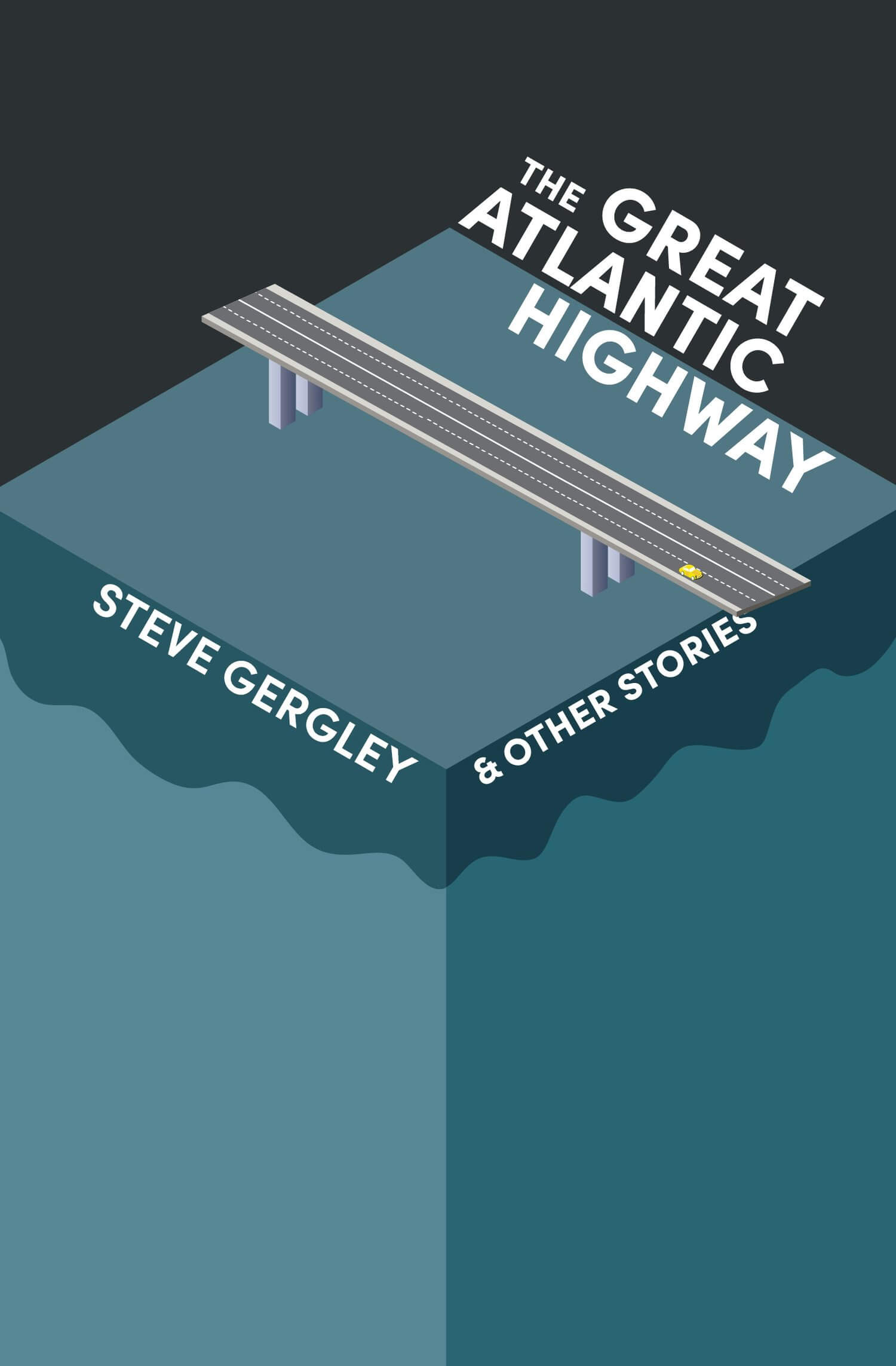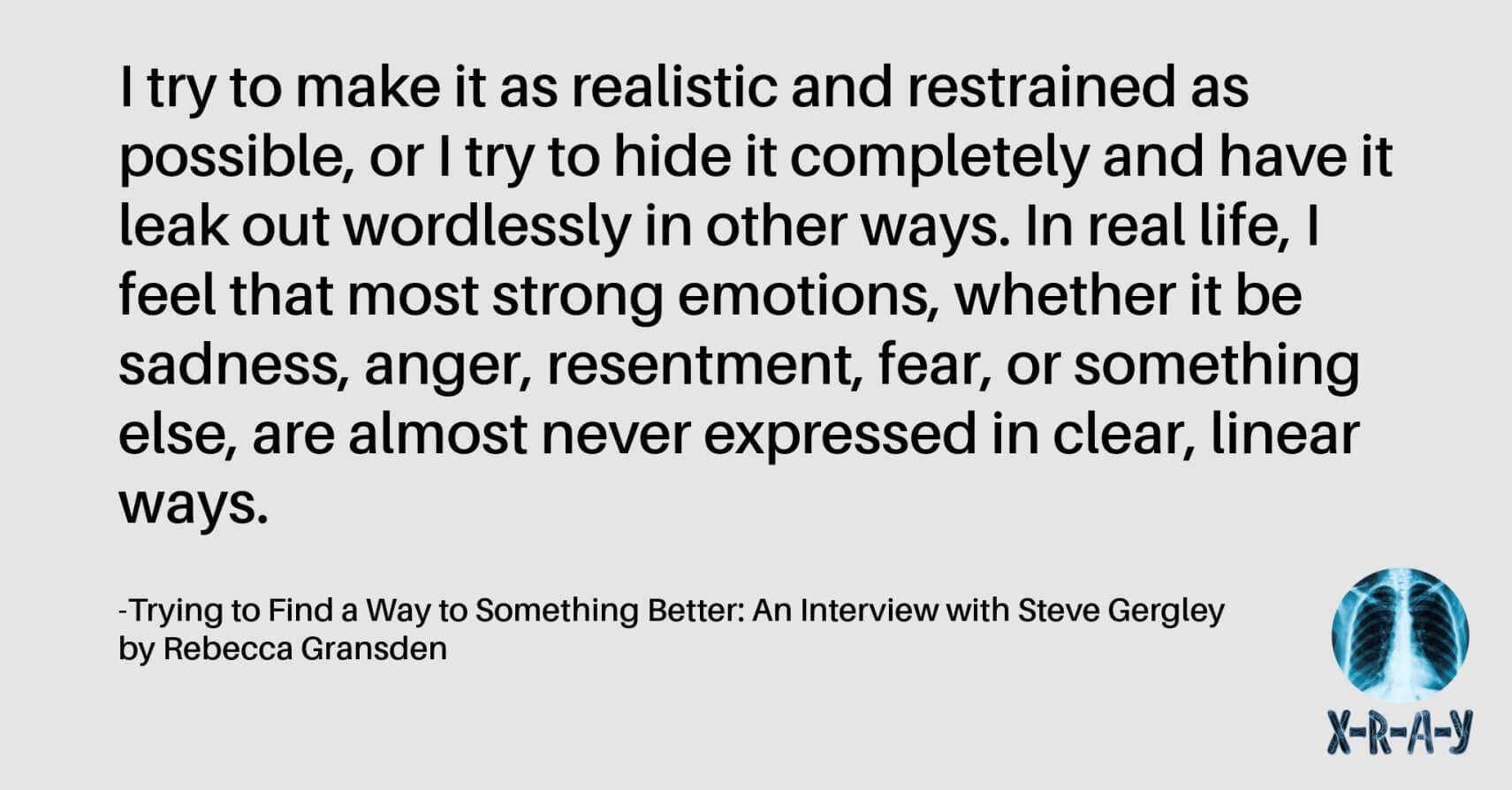 Since 2022’s A Quick Primer on Wallowing in Despair: Stories (LEFTOVER Books) Steve Gergley has been steadily and consistently adding to an impressive body of work. The Great Atlantic Highway & Other Stories (Malarkey, 2024) is a showcase for Gergley’s specialties, and reflects the ache at the center of modern existence. Contemporary fables grounded in grit follow tales of high weirdness, and the mundane frequently threatens to be undone. A fuzz pedal is just as likely to be encountered as a strange angel. I spoke to Steve about the collection.
Since 2022’s A Quick Primer on Wallowing in Despair: Stories (LEFTOVER Books) Steve Gergley has been steadily and consistently adding to an impressive body of work. The Great Atlantic Highway & Other Stories (Malarkey, 2024) is a showcase for Gergley’s specialties, and reflects the ache at the center of modern existence. Contemporary fables grounded in grit follow tales of high weirdness, and the mundane frequently threatens to be undone. A fuzz pedal is just as likely to be encountered as a strange angel. I spoke to Steve about the collection.
Rebecca Gransden: Like it always felt like no matter what I did, I could never find a way to get the words in my head out onto the paper in the right order.
The above quote is taken from the story that opens the collection, “President Whitmore’s Basement.” Do you regard yourself as a prolific writer? Are there times when ideas fail to translate to the page? When thinking about this collection, do any of the stories stand out as having been particularly difficult or, alternatively, easy to write?
Steve Gergley: I do regard myself as a prolific writer, but I try my best to never sacrifice quality for the sake of quantity. I just want to keep getting better, and one of the most important ways for me to do that is to get a lot of reps. So I’m always working on something. That being said, there are a lot of days when I don’t have a single idea of what to write about, or, if I do have an idea or two, I don’t know how to write those stories. Often, searching for the most interesting way to write the story I’m thinking about is more difficult than generating the idea for the story in the first place.
As for this collection, some of the weirder, more high-concept stories such as “Thin Man,” “On Location,” and “Window Teeth,” flowed quite easily, while other, more “standard” stories like “All the Things You Do,” and, “A Text from Zoey,” required a huge amount of grinding, hard work, and refinement to complete.
RG: The collection frequently presents the world of work as insecure, confusing and in possession of inherent strangeness. Would you agree that a common theme of your work is the injection of weirdness and absurdity into the working day?
SG: Yeah, I would agree with that, and that appeals to me because my own daily days at work are so boring and repetitive. So I’m definitely making up for the mundanity in my real life by writing these stories where interesting / weird stuff happens. But then again, I think it would be pretty stressful to be in some of these situations in real life, so it’s probably best they stay in the realm of my imagination, haha.
RG: “A Face to Put on Top of Your Face” has the quality of a modern fable, taking your propensity for combining the surreal with the mundane into the realm of deep symbolism. Small, everyday details add weight to the more fantastical elements, grounding the story, and the narrative addresses fundamental psychological angsts. Did you experience discomfort or uneasiness when writing any of the stories for The Great Atlantic Highway & Other Stories?
SG: It’s always uncomfortable for me to write about personal subjects like those addressed in that story, so that one was definitely difficult to write. But once it was finished and polished up into a state I was satisfied with, it was pretty cathartic. The whole purpose of any kind of artistic expression is to communicate an emotion of some kind, so it feels good to be able to do that. “Wes,” and “Thanksgiving Eve,” are two other pieces that were difficult to complete but satisfying when completed.

RG: A recurring theme for you is the inclusion of references to popular culture, most often in the form of TV shows, films and well known figures. A good example of this is “On Location” where a film shoot takes a wild turn. Why do you think this provides such impetus for your writing?
SG: I include many references to those things in my writing because they have a big influence on my life in general. I love movies, TV shows, and art just as much as books, so there are so many images, characters, and lines of dialogue from movies and TV shows that have stuck with me for years after my first viewing. Also, I like to ground my stories in a world that is as realistic as possible, where other popular works of media exist. I don’t enjoy writing as much when the characters seem to exist in this weird parallel universe where TV shows and movies like The Wire and Independence Day just don’t exist. For some reason that feels a little bit phony and bloodless to me.
RG: “I Smell Death on You” raises the eternal questions of life and death, meaning, and existence. Often these questions come at us from the most unexpected of places, and if we receive any answers they can be cryptic. When you look at the collection, which stories stand out to you as dealing with the ‘big’ questions?
SG: I think most of them, if not all, deal with something similar to that. Whether it’s life and death, the appearance of unexpected pregnancy, the secret of a cheating spouse being revealed, how to survive during wartime, trying to re-enter society after a serious injury, the death of a family member, serious career uncertainty . . . I think all of these things are pretty big inflection points in a person’s life.
RG: The stories selected for the collection vary in length, from flash fiction to long short story. How did you decide which pieces to include?
SG: The most important consideration was to include the best stories. Or the ones I like the best at least. After that, I tried to sequence the collection to have a nice ebb and flow between short and long, and between surreal and grounded. I didn’t want the transitions between those two extremes to be too jarring.
RG: A theme which recurs in the collection is that of chance encounters that possess a surreal quality, often suggesting a revelation or deeper meaning. Have you experienced this type of interaction in real life? What attracts you to this scenario?
SG: I’ve had a number of interesting occurrences like that in real life, and I’ve always been intrigued by them. For me, it’s the possibility of an unexpected force or person stepping into your life for a short time and taking it in a direction you never could have predicted. The moment that person shows up, absolutely anything can happen. And that’s the most exciting thing any story can do.
RG: Many of your characters are thinking about another life, either an alternative one or a projected future existence. Do you have any insight into why this might be?
SG: I’ve worked soul-crushing retail and warehouse jobs for the past fifteen years, and during that time, I spent nearly every day trying to find a way to something better. So that struggle is something very familiar to me. The people trapped in those jobs and those lives are the ones who I know, and who I like to write about.
RG: I am the hanging man. For two days I’ve hung from this elm. There’s a rope around my ruined neck. Flies walk on my open eyes.
The stories “Hanging” (from which the above quote is lifted) and “Burning” act as a duo, and in their own striking ways address the profound mystery of religious experience. What part does faith, or the lack of, play in your writing?
SG: You expressed it right there with the words, “profound mystery.” I’m not religious myself at all, but I am very interested in all the weird little mysteries that can be hiding in plain sight that nobody ever notices because they never look in that direction for very long. These two stories are about a much bigger, more grand event than that, but I’m very drawn to the mystery of that weird, tiny house at the end of the dead-end street with the boarded up windows and the brand new car parked in the driveway. Each time I drive by something like that, I always ask myself: why is a brand new car parked by a house like that? Does someone actually live there, or are they just cleaning it out before selling the land the house is built on? Or did they lose something in there? Or is something more sinister going on? In real life, the answer is usually very boring, but like you said, the mystery of the whole thing is endlessly fascinating.
RG: “Do You Like Death Metal?”
Well, do you?
SG: Yeah, without a doubt, I’m a big fan. Some of my favorite bands are Nile, Ulcerate, Artificial Brain, Blood Incantation, Ruin Lust, Gorguts, and many others.
RG: “Ghost Baby” addresses sadness that exists beyond death. How do you approach the use of melancholy in your work?
SG: I try to make it as realistic and restrained as possible, or I try to hide it completely and have it leak out wordlessly in other ways. In real life, I feel that most strong emotions, whether it be sadness, anger, resentment, fear, or something else, are almost never expressed in clear, linear ways. They’re always hidden beneath the surface of the psyche, morphing into distorted thoughts, compulsions, and desires, and by the time those emotions do leak out, they’re warped and misshapen to the point that they’re not even recognizable anymore. And that’s much more interesting to me than something that’s clear and direct.
RG: Several of the stories make reference to how religious meaning can be projected onto the physical body. I’m thinking in particular of “God’s Thumb” and “Richie’s Vacation”. What attracts you to this theme?
SG: The deep weirdness of the idea is what’s really intriguing to me. It’s the practice of taking religion and religious meaning, which is something I consider to be a mental construct, and applying that to the human body, which is the basis of all physical experience due to it being the home of the senses. To me, those two realms (the mental and the physical) sit on opposite ends of the human experience, so trying to mash them together through (in the case of these two stories) painful and grotesque rituals is a compelling contrast. It’s like trying to jam the key to your front door into the lock of your neighbor’s house. There’s going to be a lot of struggle there, and if you keep pressing, either the key or the lock are going to get damaged.
RG: One of my favorite stories featured in the collection is “The Girl Who Was a Doorway,” which takes a simple but ingenious concept to unexpected places. When approaching high concept pieces, are you looking for a balance of elements?
SG: Thanks for the kind words! And yeah, when working on something like that, I try to work out all the elements, no matter how weird or surreal, to make sure that the world of the story has a sound internal logic. In addition to that, I like to make sure the non-surreal elements of the story are as grounded in reality as possible. That way, it gives the reader the feeling that these reality-defying events could really be happening somewhere nearby in real life, even if they’re not front-page news stories. I like the idea of these kinds of events floating quietly on the fringes of society, being hidden away from everyone, except for the select few people who are experiencing it directly.
RG: For “Howdy Stranger, This is Howser” you take on the world of online connection, and the difficulties that can arise when navigating it. How do you view your own use of online messaging and social media? Does the online space impact your writing life?
SG: The online space impacts my writing life a little bit, but not too much. I don’t pay much attention to gossip or feuds or anything like that that happens in the online writing community. I just like to read the work of other writers, and if I enjoy a story or poem, I’ll highlight it and post a link. As for my own use of social media, I have a policy of 100% positivity. There is enough negativity online. I don’t need to add more to it. So I only post positive things. If I’m having a bad day or experiencing some strong negative emotions, I just step away from the computer and go do a workout or something.
RG: Clusters of bearded guys with shining, styled hair and analog watches of brushed steel joked loudly near flat screen TVs affixed to the walls. Mixed groups of men and women in their thirties sat at square tables and chatted over half-empty glasses and froth-stitched pitchers of beer. One-time acquaintances and people he had known but never met passed by with less hair, plumper faces, unfamiliar glasses, new piercings, fresh tattoos, glittering wedding rings, and grinning partners from other states.
In “Thanksgiving Eve,” the protagonist Skip, having been struck by lightning and left with multiple long term problems, decides to visit a local watering hole where he’ll run into people familiar to him from high school. When there, he finds his issues amplified when faced with comparing his lot with the lives of his former peer group. There can often be an uncanny quality to a situation like this, or sudden feeling of existential dread. Is this story inspired by a specific incident? What is the role of fate in “Thanksgiving Eve”?
SG: That story is heavily influenced by a night that really happened, and writing it was a cathartic exercise for me. Many elements are changed from reality and many are not, but the big takeaway for me is that every event in your life is a probabilistic roll of the dice that you have no control over, so all you can do is to keep trying to make the best of each new situation that comes your way, and continue moving forward into the future.
Read more from Steve Gergley in the X-R-A-Y archives.
Steve Gergley is the author of The Great Atlantic Highway & Other Stories (Malarkey Books ’24), There Are Some Floors Missing (Bullshit Lit ’24), Skyscraper (West Vine Press ’23), and A Quick Primer on Wallowing in Despair (Leftover Books ’22). His short fiction has appeared or is forthcoming in X-R-A-Y Literary Magazine, Pithead Chapel, Maudlin House, Passages North, Hobart, Always Crashing, and others. He tweets @GergleySteve. His fiction can be found at: https://stevegergleyauthor.

